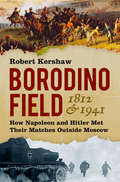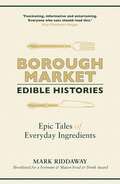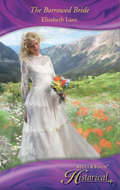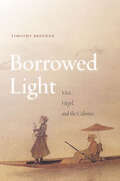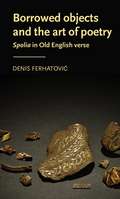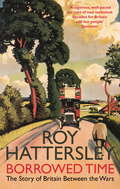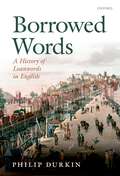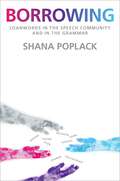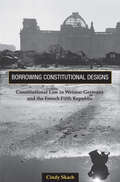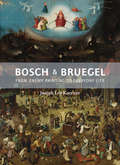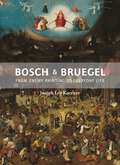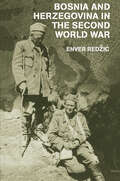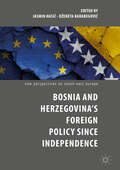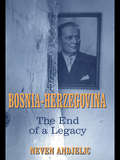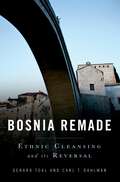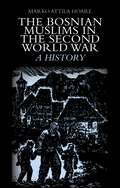- Table View
- List View
Borodino Field 1812 & 1941: How Napoleon and Hitler Met Their Matches Outside Moscow
by Robert KershawThe Battle of Borodino resonates with the patriotic soul of Mother Russia. The epic confrontation in September 1812 was the single bloodiest day of the Napoleonic Wars, leaving France’s Grande Armée limping to the gates of Moscow and on to catastrophe in snow and ice. Generations later, in October 1941, an equally bitter battle was fought at Borodino. This time Hitler's SS and Panzers came up against elite Siberian troops defending Stalin's Moscow. Remarkably, both conflicts took place in the same woods and gullies that follow the sinuous line of the Koloch River. Borodino Field relates the gruelling experience of the French army in Russia, juxtaposed with the personal accounts, diaries and letters of SS and Panzer soldiers during the Second World War. Acclaimed historian Robert Kershaw draws on previously untapped archives to narrate the odyssey of soldiers who marched along identical tracks and roads on the 1,000-kilometre route to Moscow, and reveals the astonishing parallels and contrasts between two battles fought on Russian soil, over one hundred years apart.
Borough Market: Epic tales of everyday ingredients
by Mark RiddawayAs a nation of food-lovers we have been munching on fruit and veg, drinking tea and coffee and adorning our dishes with oils and spices for generations, but have you ever stopped to wonder how our most beloved foods came to be the way they are now?In this series of enlightening and highly entertaining essays, award-winning food writer Mark Riddaway travels back through the centuries to tell the fascinating, surprising and often downright bizarre stories of some of the everyday ingredients found at London's Borough Market.Discover how the strawberries we eat today had their roots in a clandestine trip to South America by a French spy whose surname happened to be Strawberry, why three-quarters of Britain's late-18th-century intake of tea was sold on the black market, and what Sigmund Freud found so fascinating about eel genitalia.From the humble apples and onions that we've grown on these shores for centuries, to more exotic ingredients like cinnamon and bananas that travel from across the world to finesse our food, Borough Market: Edible Histories offers a chance to digest the charming stories behind every last morsel.
The Borrowed Bride: The Hand-me-down Bride The Bride Wore Britches Something Borrowed, Something True (Mills And Boon Historical Ser.)
by Elizabeth LaneIndulge your fantasies of delicious Regency Rakes, fierce Viking warriors and rugged Highlanders. Be swept away into a world of intense passion, lavish settings and romance that burns brightly through the centuries ‘We’re going to have a child. You need to come home so we can get married. ’
Borrowed Light: Vico, Hegel, and the Colonies
by Timothy BrennanA critical revaluation of the humanist tradition, Borrowed Light makes the case that the 20th century is the "anticolonial century." The sparks of concerted resistance to colonial oppression were ignited in the gathering of intellectual malcontents from all over the world in interwar Europe. Many of this era's principal figures were formed by the experience of revolution on Europe's semi-developed Eastern periphery, making their ideas especially pertinent to current ideas about autonomy and sovereignty. Moreover, the debates most prominent then—human vs. inhuman, religions of the book vs. oral cultures, the authoritarian state vs. the representative state and, above all, scientific rationality vs. humanist reason—remain central today. Timothy Brennan returns to the scientific Enlightenment of the 17th century and its legacies. In readings of the showdown between Spinoza and Vico, Hegel's critique of liberalism, and Nietzsche's antipathy towards the colonies and social democracy, Brennan identifies the divergent lines of the first anticolonial theory—a literary and philosophical project with strong ties to what we now call Marxism. Along the way, he assesses prospects for a renewal of the study of imperial culture.
Borrowed objects and the art of poetry: <i>Spolia</i> in Old English verse (Manchester Medieval Literature and Culture)
by Denis FerhatovicThis study examines Exeter riddles, Anglo-Saxon biblical poems (Exodus, Andreas, Judith) and Beowulf in order to uncover the poetics of spolia, an imaginative use of recycled fictional artefacts to create sites of metatextual reflection. Old English poetry famously lacks an explicit ars poetica. This book argues that attention to particularly charged moments within texts – especially those concerned with translation, transformation and the layering of various pasts – yields a previously unrecognised means for theorising Anglo-Saxon poetic creativity. Borrowed objects and the art of poetry works at the intersections of materiality and poetics, balancing insights from thing theory and related approaches with close readings of passages from Old English texts.
Borrowed objects and the art of poetry: <i>Spolia</i> in Old English verse (Manchester Medieval Literature and Culture)
by Denis FerhatovicThis study examines Exeter riddles, Anglo-Saxon biblical poems (Exodus, Andreas, Judith) and Beowulf in order to uncover the poetics of spolia, an imaginative use of recycled fictional artefacts to create sites of metatextual reflection. Old English poetry famously lacks an explicit ars poetica. This book argues that attention to particularly charged moments within texts – especially those concerned with translation, transformation and the layering of various pasts – yields a previously unrecognised means for theorising Anglo-Saxon poetic creativity. Borrowed objects and the art of poetry works at the intersections of materiality and poetics, balancing insights from thing theory and related approaches with close readings of passages from Old English texts.
Borrowed Time: The Story of Britain Between the Wars
by Roy HattersleyCalled an uneasy peace, the twenty years between the wars were a time of turmoil - Britain saw a general strike and the worst economic crisis in its history, armed rebellion in Ireland and open revolt in India, a Prime Minister's resignation and the King's abdication. Crisis followed crisis until Britain was engulfed in the Second World War - a catastrophe that could have been foreseen, possibly even prevented. But there were also moments of triumph: England regained the Ashes and Britain ran to glory in the 'Chariots of Fire' Olympic Games; the BBC was born and became the envy of the free world; there was a renaissance in poetry, sculpture of genius, and cinema lightened the darkness for millions. However it is the politicians who failed who have really come to personify the interwar years - in particular Ramsey MacDonald and Stanley Baldwin. Both prime ministers were better men than history allows. And Winston Churchill? Right or wrong, success or failure, he is the irrepressible force in what he called the 'years for the locusts to eat'. Hattersley's assessment of this doomed era is illuminating, entertaining and bold.
Borrowed Words: A History of Loanwords in English
by Philip DurkinThe rich variety of the English vocabulary reflects the vast number of words it has taken from other languages. These range from Latin, Greek, Scandinavian, Celtic, French, Italian, Spanish, and Russian to, among others, Hebrew, Maori, Malay, Chinese, Hindi, Japanese, andYiddish. Philip Durkin's full and accessible history reveals how, when, and why. He shows how to discover the origins of loanwords, when and why they were adopted, and what happens to them once they have been. The long documented history of English includes contact with languages in a variety of contexts, including: the dissemination of Christian culture in Latin in Anglo-Saxon England, and the interactions of French, Latin, Scandinavian, Celtic, and English during the Middle Ages; exposure to languages throughout the world during the colonial era; and the effects of using English as an international language of science. Philip Durkin describes these and other historical inputs, introducing the approaches each requires, from the comparative method for the earliest period to documentary and corpus research in the modern. The discussion is illustrated at every point with examples taken from a variety of different sources. The framework Dr Durkin develops can be used to explore lexical borrowing in any language. This outstanding book is for everyone interested in English etymology and in loanwords more generally. It will appeal to a wide general public and at the same time offers a valuable reference for scholars and students of the history of English.
Borrowing: Loanwords in the Speech Community and in the Grammar
by Shana PoplackStudies of bilingual behavior have been proliferating for decades, yet short shrift has been given to its major manifestation, the incorporation of words from one language into the discourse of another. This volume redresses that imbalance by going straight to the source: bilingual speakers in their social context. Building on more than three decades of original research based on vast quantities of spontaneous performance data and a highly ramified analytical apparatus, Shana Poplack characterizes the phenomenon of lexical borrowing in the speech community and in the grammar, both synchronically and diachronically. In contrast to most other treatments, which deal with the product of borrowing (if they consider it at all), this book examines the process: how speakers go about incorporating foreign items into their bilingual discourse; how they adapt them to recipient-language grammatical structure; how these forms diffuse across speakers and communities; how long they persist in real time; and whether they change over the duration. Attacking some of the most contentious issue in language mixing research empirically, it tests hypotheses about established loanwords, nonce borrowings and code-switches on a wealth of unique datasets on typologically similar and distinct language pairs. A major focus is the detailed analysis of integration: the principal mechanism underlying the borrowing process. Though the shape the borrowed form assumes may be colored by community convention, Poplack shows that the act of transforming donor-language elements into native material is universal. Emphasis on actual speaker behavior coupled with strong standards of proof, including data-driven reports of rates of occurrence, conditioning of variant choice and measures of statistical significance, make Borrowing an indispensable reference on language contact and bilingual behavior.
BORROWING C: Loanwords in the Speech Community and in the Grammar
by Shana PoplackStudies of bilingual behavior have been proliferating for decades, yet short shrift has been given to its major manifestation, the incorporation of words from one language into the discourse of another. This volume redresses that imbalance by going straight to the source: bilingual speakers in their social context. Building on more than three decades of original research based on vast quantities of spontaneous performance data and a highly ramified analytical apparatus, Shana Poplack characterizes the phenomenon of lexical borrowing in the speech community and in the grammar, both synchronically and diachronically. In contrast to most other treatments, which deal with the product of borrowing (if they consider it at all), this book examines the process: how speakers go about incorporating foreign items into their bilingual discourse; how they adapt them to recipient-language grammatical structure; how these forms diffuse across speakers and communities; how long they persist in real time; and whether they change over the duration. Attacking some of the most contentious issue in language mixing research empirically, it tests hypotheses about established loanwords, nonce borrowings and code-switches on a wealth of unique datasets on typologically similar and distinct language pairs. A major focus is the detailed analysis of integration: the principal mechanism underlying the borrowing process. Though the shape the borrowed form assumes may be colored by community convention, Poplack shows that the act of transforming donor-language elements into native material is universal. Emphasis on actual speaker behavior coupled with strong standards of proof, including data-driven reports of rates of occurrence, conditioning of variant choice and measures of statistical significance, make Borrowing an indispensable reference on language contact and bilingual behavior.
Borrowing Constitutional Designs: Constitutional Law in Weimar Germany and the French Fifth Republic
by Cindy SkachAfter the collapse of communism, some thirty countries scrambled to craft democratic constitutions. Surprisingly, the constitutional model they most often chose was neither the pure parliamentary model found in most of Western Europe at the time, nor the presidential model of the Americas. Rather, it was semi-presidentialism--a rare model known more generally as the "French type." This constitutional model melded elements of pure presidentialism with those of pure parliamentarism. Specifically, semi-presidentialism combined a popularly elected head of state with a head of government responsible to a legislature. Borrowing Constitutional Designs questions the hasty adoption of semi-presidentialism by new democracies. Drawing on rich case studies of two of the most important countries for European politics in the twentieth century--Weimar Germany and the French Fifth Republic--Cindy Skach offers the first theoretically focused, and historically grounded, analysis of semi-presidentialism and democracy. She demonstrates that constitutional choice matters, because under certain conditions, semi-presidentialism structures incentives that make democratic consolidation difficult or that actually contribute to democratic collapse. She offers a new theory of constitutional design, integrating insights from law and the social sciences. In doing so, Skach challenges both democratic theory and democratic practice. This book will be welcomed not only by scholars and practitioners of constitutional law but also by those in fields such as comparative politics, European politics and history, and international and public affairs.
Borrowing Constitutional Designs: Constitutional Law in Weimar Germany and the French Fifth Republic (PDF)
by Cindy SkachAfter the collapse of communism, some thirty countries scrambled to craft democratic constitutions. Surprisingly, the constitutional model they most often chose was neither the pure parliamentary model found in most of Western Europe at the time, nor the presidential model of the Americas. Rather, it was semi-presidentialism--a rare model known more generally as the "French type." This constitutional model melded elements of pure presidentialism with those of pure parliamentarism. Specifically, semi-presidentialism combined a popularly elected head of state with a head of government responsible to a legislature. Borrowing Constitutional Designs questions the hasty adoption of semi-presidentialism by new democracies. Drawing on rich case studies of two of the most important countries for European politics in the twentieth century--Weimar Germany and the French Fifth Republic--Cindy Skach offers the first theoretically focused, and historically grounded, analysis of semi-presidentialism and democracy. She demonstrates that constitutional choice matters, because under certain conditions, semi-presidentialism structures incentives that make democratic consolidation difficult or that actually contribute to democratic collapse. She offers a new theory of constitutional design, integrating insights from law and the social sciences. In doing so, Skach challenges both democratic theory and democratic practice. This book will be welcomed not only by scholars and practitioners of constitutional law but also by those in fields such as comparative politics, European politics and history, and international and public affairs.
Bosch and Bruegel: From Enemy Painting to Everyday Life (PDF)
by Joseph Leo KoernerIn this visually stunning and much anticipated book, acclaimed art historian Joseph Koerner casts the paintings of Hieronymus Bosch and Pieter Bruegel in a completely new light, revealing how the painting of everyday life was born from what seems its polar opposite: the depiction of an enemy hell-bent on destroying us.Supreme virtuoso of the bizarre, diabolic, and outlandish, Bosch embodies the phantasmagorical force of painting, while Bruegel, through his true-to-life landscapes and frank depictions of peasants, is the artistic avatar of the familiar and ordinary. But despite their differences, the works of these two artists are closely intertwined. Bruegel began his career imitating Bosch's fantasies, and it was Bosch who launched almost the whole repertoire of later genre painting. But Bosch depicts everyday life in order to reveal it as an alluring trap set by a metaphysical enemy at war with God, whereas Bruegel shows this enemy to be nothing but a humanly fabricated mask. Attending closely to the visual cunning of these two towering masters, Koerner uncovers art history’s unexplored underside: the image itself as an enemy.An absorbing study of the dark paradoxes of human creativity, Bosch and Bruegel is also a timely account of how hatred can be converted into tolerance through the agency of art. It takes readers through all the major paintings, drawings, and prints of these two unforgettable artists—including Bosch’s notoriously elusive Garden of Earthly Delights, which forms the core of this historical tour de force. Elegantly written and abundantly illustrated, the book is based on Koerner’s A. W. Mellon Lectures in the Fine Arts, a series given annually at the National Gallery of Art, Washington.
Bosch and Bruegel: From Enemy Painting to Everyday Life (PDF)
by Joseph Leo KoernerIn this visually stunning and much anticipated book, acclaimed art historian Joseph Koerner casts the paintings of Hieronymus Bosch and Pieter Bruegel in a completely new light, revealing how the painting of everyday life was born from what seems its polar opposite: the depiction of an enemy hell-bent on destroying us.Supreme virtuoso of the bizarre, diabolic, and outlandish, Bosch embodies the phantasmagorical force of painting, while Bruegel, through his true-to-life landscapes and frank depictions of peasants, is the artistic avatar of the familiar and ordinary. But despite their differences, the works of these two artists are closely intertwined. Bruegel began his career imitating Bosch's fantasies, and it was Bosch who launched almost the whole repertoire of later genre painting. But Bosch depicts everyday life in order to reveal it as an alluring trap set by a metaphysical enemy at war with God, whereas Bruegel shows this enemy to be nothing but a humanly fabricated mask. Attending closely to the visual cunning of these two towering masters, Koerner uncovers art history’s unexplored underside: the image itself as an enemy.An absorbing study of the dark paradoxes of human creativity, Bosch and Bruegel is also a timely account of how hatred can be converted into tolerance through the agency of art. It takes readers through all the major paintings, drawings, and prints of these two unforgettable artists—including Bosch’s notoriously elusive Garden of Earthly Delights, which forms the core of this historical tour de force. Elegantly written and abundantly illustrated, the book is based on Koerner’s A. W. Mellon Lectures in the Fine Arts, a series given annually at the National Gallery of Art, Washington.
Bosch and Bruegel: From Enemy Painting to Everyday Life (PDF)
by Joseph Leo KoernerIn this visually stunning and much anticipated book, acclaimed art historian Joseph Koerner casts the paintings of Hieronymus Bosch and Pieter Bruegel in a completely new light, revealing how the painting of everyday life was born from what seems its polar opposite: the depiction of an enemy hell-bent on destroying us.Supreme virtuoso of the bizarre, diabolic, and outlandish, Bosch embodies the phantasmagorical force of painting, while Bruegel, through his true-to-life landscapes and frank depictions of peasants, is the artistic avatar of the familiar and ordinary. But despite their differences, the works of these two artists are closely intertwined. Bruegel began his career imitating Bosch's fantasies, and it was Bosch who launched almost the whole repertoire of later genre painting. But Bosch depicts everyday life in order to reveal it as an alluring trap set by a metaphysical enemy at war with God, whereas Bruegel shows this enemy to be nothing but a humanly fabricated mask. Attending closely to the visual cunning of these two towering masters, Koerner uncovers art history’s unexplored underside: the image itself as an enemy.An absorbing study of the dark paradoxes of human creativity, Bosch and Bruegel is also a timely account of how hatred can be converted into tolerance through the agency of art. It takes readers through all the major paintings, drawings, and prints of these two unforgettable artists—including Bosch’s notoriously elusive Garden of Earthly Delights, which forms the core of this historical tour de force. Elegantly written and abundantly illustrated, the book is based on Koerner’s A. W. Mellon Lectures in the Fine Arts, a series given annually at the National Gallery of Art, Washington.
Bosch and Bruegel: From Enemy Painting to Everyday Life (The A. W. Mellon Lectures in the Fine Arts #57)
by Joseph Leo KoernerA bold new interpretation of two northern Renaissance mastersIn this visually stunning and much anticipated book, acclaimed art historian Joseph Koerner casts the paintings of Hieronymus Bosch and Pieter Bruegel in a completely new light, revealing how the painting of everyday life was born from what seems its polar opposite: the depiction of an enemy hell-bent on destroying us.Supreme virtuoso of the bizarre, diabolic, and outlandish, Bosch embodies the phantasmagorical force of painting, while Bruegel, through his true-to-life landscapes and frank depictions of peasants, is the artistic avatar of the familiar and ordinary. But despite their differences, the works of these two artists are closely intertwined. Bruegel began his career imitating Bosch's fantasies, and it was Bosch who launched almost the whole repertoire of later genre painting. But Bosch depicts everyday life in order to reveal it as an alluring trap set by a metaphysical enemy at war with God, whereas Bruegel shows this enemy to be nothing but a humanly fabricated mask. Attending closely to the visual cunning of these two towering masters, Koerner uncovers art history’s unexplored underside: the image itself as an enemy.An absorbing study of the dark paradoxes of human creativity, Bosch and Bruegel is also a timely account of how hatred can be converted into tolerance through the agency of art. It takes readers through all the major paintings, drawings, and prints of these two unforgettable artists—including Bosch’s notoriously elusive Garden of Earthly Delights, which forms the core of this historical tour de force. Elegantly written and abundantly illustrated, the book is based on Koerner’s A. W. Mellon Lectures in the Fine Arts, a series given annually at the National Gallery of Art, Washington.Published in association with the Center for Advanced Study in the Visual Arts, National Gallery of Art, Washington, DCPlease note: All images in this ebook are presented in black and white and have been reduced in size.
Bosnia and Herzegovina in the Second World War
by Enver RedzicFive major groups fought one another in Bosnia and Herzegovina during the Second World War: The German and Italian occupiers, the Serbian Chetniks, the Ustasha of the Independent State of Croatia, the Bosnian Muslims, and the Tito-led Partisans. The aims, policies, and actions of each group are examined in light of their own documents and those of rival groups. This work shows how the Partisans prevailed over other groups because of their ideological appeal, superior discipline, and success in winning the support of large numbers of uncommitted Bosnians, particularly the Bosnian Muslims.
Bosnia and Herzegovina in the Second World War
by Enver RedzicFive major groups fought one another in Bosnia and Herzegovina during the Second World War: The German and Italian occupiers, the Serbian Chetniks, the Ustasha of the Independent State of Croatia, the Bosnian Muslims, and the Tito-led Partisans. The aims, policies, and actions of each group are examined in light of their own documents and those of rival groups. This work shows how the Partisans prevailed over other groups because of their ideological appeal, superior discipline, and success in winning the support of large numbers of uncommitted Bosnians, particularly the Bosnian Muslims.
Bosnia and Herzegovina’s Foreign Policy Since Independence (New Perspectives on South-East Europe)
by Jasmin Hasić Dženeta KarabegovićThis book is the first to provide a comprehensive and systematic analysis of the foreign policy of Bosnia and Herzegovina, a post-conflict country with an active agency in international affairs. Bridging academic and policy debates, the book summarizes and further examines the first twenty-five years of BiH’s foreign policy following the country’s independence from Yugoslavia in 1992. Topics covered include conflict and post-conflict periods, Euro-Atlantic integration, political affairs on both local and regional levels, integration with a variety of international organizations and actors, neighboring states, bilateral relations with relevant other states including the United States, Russia, selected EU countries, and Turkey, as well as BiH’s diaspora. The book highlights that despite their apparent weakness, post-conflict states have agency to carry out foreign policy goals and engage with the international sphere, including in geopolitics, and thus provides a novel insight into weak states and their role in international politics.
Bosnia-Herzegovina: The End of a Legacy
by Dr Neven Andjelic Neven AndjelicWhen the war in Bosnia-Herzegovina broke out a baffled world sought explanations from a range of experts who offered a variety of reasons for the conflict. The author of this study takes Bosnian affairs seriously and in so doing makes it much easier to grasp why the war occurred.
Bosnia-Herzegovina: The End of a Legacy
by Dr Neven Andjelic Neven AndjelicWhen the war in Bosnia-Herzegovina broke out a baffled world sought explanations from a range of experts who offered a variety of reasons for the conflict. The author of this study takes Bosnian affairs seriously and in so doing makes it much easier to grasp why the war occurred.
Bosnia-Herzegovina: The Vance/Owen Peace Plan
by David Anthony Llewellyn OwenIn 1992 David Owen was appointed the EU Co-Chairman of the International Conference on the Former Yugoslavia, working alongside the UN’s Co-Chairman, Cyrus Vance. The papers collected here provide fascinating primary source material and an insider’s account of the intense international political activity at that time, which culminated in the Vance-Owen Peace Plan (VOPP). At a time when the international community is looking again at whether and how the Dayton Accords and the 1995 division into two entities should be adjusted in Bosnia-Herzegovina, Owen highlights elements of the VOPP which are of continuing relevance and which can guide political debate and decisions in 2012 and thereafter. Sadly, Bosnia-Herzegovina is still deeply divided, a direct consequence of not imposing the VOPP. The book reminds the international community and the people of Bosnia-Herzegovina that a unified structure for their country is still achievable.
Bosnia Remade: Ethnic Cleansing and its Reversal
by Carl T. Dahlman Gerard ToalBosnia Remade is an authoritative account of ethnic cleansing and its partial undoing from the onset of the 1990s Bosnian wars up through the present. Gerard Toal and Carl Dahlman combine a bird's-eye view of the entire war from onset to aftermath with a micro-level account of three towns that underwent ethnic cleansing and--later--the return of refugees. There have been two major attempts to remake the ethnic geography of Bosnia since 1991. In the first instance, ascendant ethno-nationalist forces tried to eradicate the mixed ethnic geographies of Bosnia's towns, villages and communities. These forces devastated tens of thousands of homes and lives, but they failed to destroy Bosnia-Herzegovina as a polity. In the second attempt, which followed the war, the international community, in league with Bosnian officials, endeavored to reverse the demographic and other consequences of this ethnic cleansing. While progress has been uneven, this latter effort has transformed the ethnic demography of Bosnia and moved the nation beyond its recent segregationist past. By showing how ethnic cleansing was challenged, Bosnia Remade offers more than just a comprehensive narrative of Europe's worst political crisis of the past two decades. It also offers lessons for addressing an enduring global problem.
Bosnia Remade: Ethnic Cleansing and its Reversal
by Carl T. Dahlman Gerard ToalBosnia Remade is an authoritative account of ethnic cleansing and its partial undoing from the onset of the 1990s Bosnian wars up through the present. Gerard Toal and Carl Dahlman combine a bird's-eye view of the entire war from onset to aftermath with a micro-level account of three towns that underwent ethnic cleansing and--later--the return of refugees. There have been two major attempts to remake the ethnic geography of Bosnia since 1991. In the first instance, ascendant ethno-nationalist forces tried to eradicate the mixed ethnic geographies of Bosnia's towns, villages and communities. These forces devastated tens of thousands of homes and lives, but they failed to destroy Bosnia-Herzegovina as a polity. In the second attempt, which followed the war, the international community, in league with Bosnian officials, endeavored to reverse the demographic and other consequences of this ethnic cleansing. While progress has been uneven, this latter effort has transformed the ethnic demography of Bosnia and moved the nation beyond its recent segregationist past. By showing how ethnic cleansing was challenged, Bosnia Remade offers more than just a comprehensive narrative of Europe's worst political crisis of the past two decades. It also offers lessons for addressing an enduring global problem.
The Bosnian Muslims in the Second World War
by Marko Attila HoareThe story of the Bosnian Muslims in World War II is an epic frequently alluded to in discussions of the 1990s Balkan conflicts, but almost as frequently misunderstood or falsified. This first comprehensive study of the topic in any language sets the record straight. Based on extensive research in the archives of Bosnia- Herzegovina, Serbia and Croatia, it traces the history of Bosnia and its Muslims from the Nazi German and Fascist Italian occupation of Yugoslavia in 1941, through the years of the Yugoslav civil war, and up to the seizure of power by the Communists and their establishment of a new Yugoslav state. The book explores the reasons for Muslim opposition to the new order established by the Nazis and Fascists in Bosnia in 1941 and the different forms this opposition took. It de- scribes how the Yugoslav Communists were able to harness part of this Muslim opposition to support their own resistance movement and revolutionary bid for power. This Muslim element in the Communists' revolution shaped its form and outcome, but ultimately had itself to be curbed as the victorious Communists consolidated their dictatorship. In doing so, they set the scene for future struggles over Yugoslavia's Muslim question.
